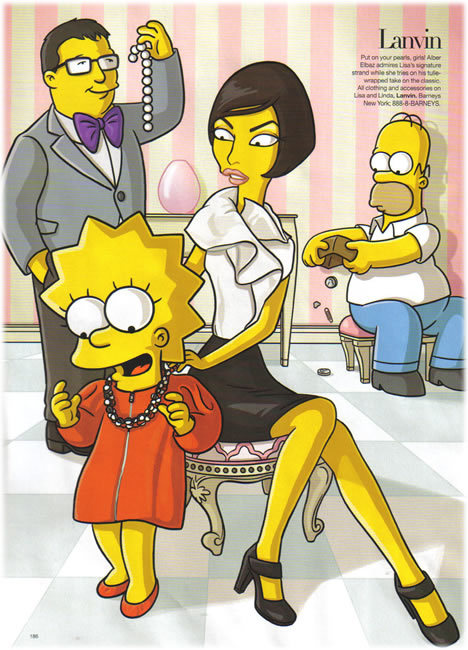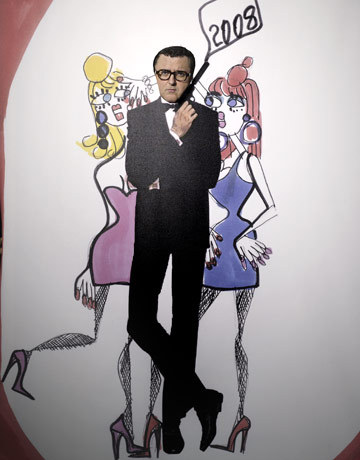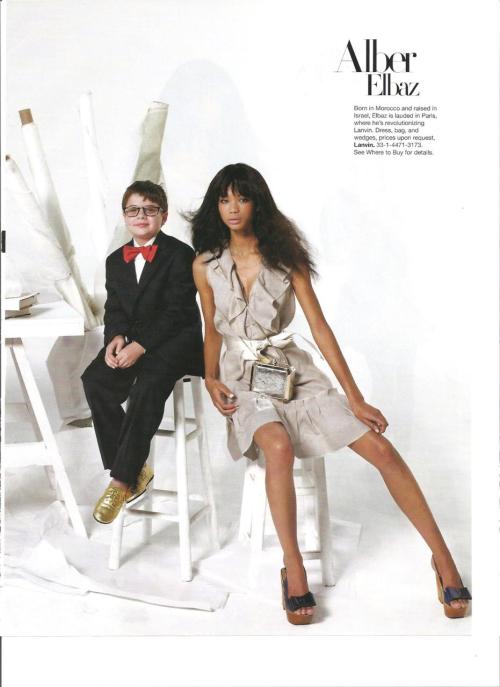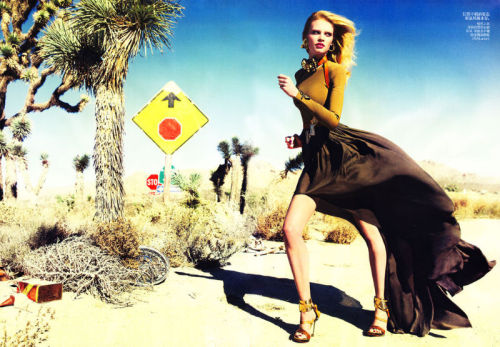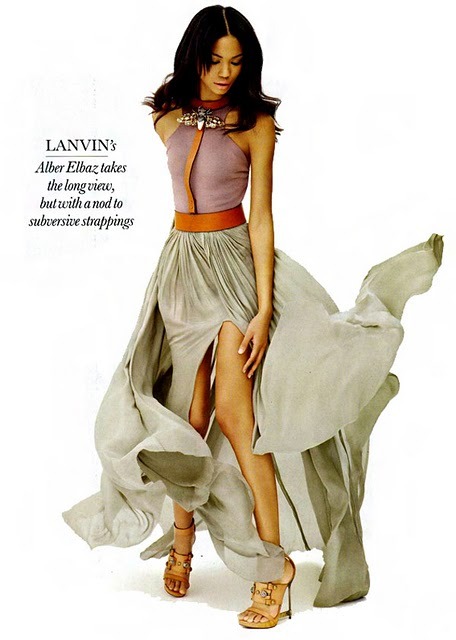ALBER ELBAZ IS A RARE BIRD in a business oft dominated by ego and drama. Humble, funny and all about the work, the beloved Lanvin designer eschews the high-profile social life of his star clients. Likening himself to "a concierge in a beautiful hotel," he feels it's best not to hobnob with the guests: "It's good not to know all these people, not to go to all these parties, to just be in the shadows a little bit and be able to dream. That way I can keep the fantasy of who they are and what they are looking for."
The Moroccan-born Elbaz began his career with Geoffrey Beene in New York before moving in 1997 to Paris, where he soon landed the top job at Yves Saint Laurent. Abruptly replaced by Tom Ford when Gucci Group bought the company, he eventually moved to Lanvin, where he has clearly had the last laugh. The world's longest-running fashion house, which was founded in 1889 by Jeanne Lanvin, was barely breathing when Elbaz arrived in 2001. Almost overnight, the designer's whisper-light frocks and beribboned accessories became favorites of both critics and consumers. A rare coupling of mystery and wearability, the clothes reflect the sensibility of their creator, who says he works from intuition and emotion and is a dogged ignorer of trends. "I want to know where is that committee in Switzerland that sits to decide what is in and what is out," he says. "I don't listen to the formula makers. I think maybe I have a selective hearing disorder."
This year, after his knockout 10th-anniversary show, Elbaz treated the crowd to a performance of "Que Sera Sera," including the gender-tweaked line, "When I was just a little boy, I asked my mother what will I be?" When he finished singing, every woman in the room was cheering, grateful for the path he'd chosen.
‘The Simpson Go to Paris with Linda Evangelista’ - Harper’s Bazaar US August 2007
“Put on your pearls, girls! Alber Elbaz admires Lisa’s signature strand while she tries on his tulle-wrapped take on the classic.”
I THINK FASHION IS ONE THING to the world, and it's another to the people who work in it. It seems like one of those glam jobs in which you wake up and don't have cereal because you have champagne, and you mostly start at 6 o'clock—not in the morning but in the evening—and by 7 you have to rush to do something else. The reality is very, very different. Producing so many collections every year, starting from scratch and turning creation into business—it is a very difficult thing to do.
There was a time when designers hated other designers. But today there is actually major respect between many of us. We understand each other. We are all going through the same stressful process. Before shows we send each other little cards with congratulations; we send each other flowers. We're kind of a crazy family, but still a family. There are many designers I really respect and love. I love Azzedine (Alaïa). I like Narciso (Rodriguez) and Marc (Jacobs) and Nicolas (Ghesquiére) from Balenciaga. The first collection Raf Simons did for Dior was gorgeous. I'm not jealous of people—I'm only jealous of people who can eat and not gain weight. I respect talent. When I see talent and when I see a good person who comes with the talent, I melt.
Fashion used to be a family business. For years and years, it was the kind of business in which mothers and fathers and children and grandchildren would all work together. And there was something in that. Because family is the only place where you feel comfortable enough to make mistakes, and in creation, mistakes are really important. They drive you forward. We have no titles at Lanvin; at lunch everybody eats together and the studio feels as one. I don't believe in a hierarchy, in a pyramid of people reporting to other people who report to me. I always say that if you really want the truth you have to go to the basement because that is where things happen. If you look for the truth in the penthouse, usually it's fake.
I feel today we have to relearn how to be small again. The industry now is very strong and very powerful and very big and loud. I think it's an important time to go back to design, to think small and to go back to creativity. It's not just about marketing, but about creativity again, about a return to intuition, to emotion. We have to bring joy to people—that's the essence of the job.
I've never worked with a muse or thought, Oh, I am so inspired by her, because I'm not doing the collection for one woman. I'm making it for different women, different ages, different body shapes, different colors. Everything can inspire you: a story, a conversation with a buyer, a need, an editor's comment. All we are as designers are infantile antennae. We are just so childish and naïve. We have to capture the moment and then we have to project that back into our work. I have an idea and sometimes it is very grand, then I have to translate it and make it relevant. For me, I don't want to see a maharajah on Fifth Avenue. So I have to ask: Is it comfortable? Can you enter a taxi? Can you have dessert if you wear that dress? And sometimes I have to be honest: "F--- the dessert, get the dress!" In the end, the most beautiful thing is that nobody will know where it comes from. The idea is that you look at a dress and say, "Well, that's a great dress." It doesn't matter if you take it from the maharajah, from Brigitte Bardot, from the '60s or the '80s. The important thing is to erase the evidence.
What do you wear in a bad economy? This is a very, very sensitive issue. On one hand, you say that when things are going sour—when everything is not as easy and fun as it used to be—maybe there is some element that can bring fun and joy again. And it's chocolates, maybe it's love, and it's a beautiful red dress. If I were a buyer today in one of the American department stores, I would go with extremes—the most beautiful, the more expensive, the more eccentric. I would take risks. The worst thing would be to buy only the little black dress. You know why? Because everyone has it already. I would go with a purple dress, something different.
On the other hand, the world is going through so many changes. People are protesting about salaries and they can't afford to buy a home. There are a lot of companies that are taking what we are creating and translating them to the masses. So we cannot be accused of eating cake when the world needs to have bread. Because in our little domain, we create ideas that are being translated by High Street a season, or even an hour, later. I think the fact that we are the source of the High Street fashion is good. A year and a half ago I did a project with H&M, which is something I would never have done before, but I thought it was important. It was about giving something to people that they could not afford, something that they only dreamed about. And it felt good to know that 95 percent of the clothes had sold around the world within four hours.
I've never felt bad about going to extremes, and it's not about how much it costs. When you work in an atelier that is located in central Paris and not on a boat in China, it's different. When you do a design and you do it seven or more times to find the right cut and the right proportion, it's not easy to get there, and that's why it's costly. I don't just buy the dresses somewhere and present them on the runway—I make them. Sometimes it takes me 10 hours to make one jacket, one skirt. The fact that you are touching something yourself brings emotion to it. I was watching a chef on television and he took a lemon and squeezed it with his hand. He said that he could do it with a machine, but he felt that if he did it with his own hand the person eating the salad would be able to taste what he put into it. I put all of me into my work. This is all I have: I don't have kids; I don't have a family that I created. But I feel that every day I create a new family. My life in that sense is complete. I find excitement at work; I don't need anything afterwards. At 10 o'clock at night, all I want to do is come home and watch Kim Kardashian get a haircut—it's like a vacation, you don't have to think.
“One woman told me that every time she wears Lanvin men fall in love with her. Another told me she wore Lanvin to face her husband's lawyer because she felt protected. ”
It seems as though every time you want to be a modernist you have to make something a little bit ugly. And if you make it really ugly then it's really modern and really cool. But beauty is never démodé. Beauty is the one thing I think everyone is seeking. That's it—to touch beautiful things, to make women feel beautiful. And this is power, you know, to feel beautiful. I always say that women are very strong and men are powerful. But beauty gives you both strength and power. I never think of it. It's just one of those natural things. It's the only thing I know how to do.
Not everything I do is perfect, but I learn from mistakes. Once I was told that a girl who had done our campaign in the previous season was out, that she was no longer the right person to use. And I was a sucker, I said okay. A month later I saw her on the street walking with her sister, and when she saw me she started to cry. She said, "Why didn't you take me, Alber?" And I felt so small and so stupid and such a victim of the system that I said, "Never again." That's what I mean when I say that I'm going back to intuition and to feeling and to what I believe.
Sometimes you don't really need armor to feel protected. Sometimes maybe you need just a chiffon dress to hug you. And if you feel that the dress hugs you and the dress loves you, you feel strong and protected. I never consider myself as doing sexy clothes at all, but then after the show people tell me, "Wow, the girls are so sexy." You know why? Because they feel fearless.
Two different women told me two different things at two different times, and I always go back to them. One person told me that every time she wears Lanvin men fall in love with her, and I thought that was so beautiful. The other one told me that she was in a taxi going to face her husband's lawyer because she was getting a divorce, but she was wearing Lanvin and she felt so protected. If I can make men fall in love with women and if I can protect women, I think I can die peacefully.
A week before he died, I called Mr. Beene and told him that everything I know he taught me. He was my boss and he was my family. I was coming out of nowhere without any grand portfolio. I didn't come from a big school. I came from Israel to New York and had a little job making mother-of-the-bride dresses. He taught me that it doesn't matter where you come from but where you are going. He never did things just because you are supposed to do them. He had the ability to create and to laugh and to make women feel beautiful and to mix technology and beauty together. I think that because he was overweight and I'm overweight, our fantasy was lightness. So we projected our fantasy to the clothes, and now all I do is light, light clothes because it's the one thing I don't have. That is why I'm too afraid to lose weight because then I might make heavy clothes. You are laughing, but I am not.
—Edited from Julia Reed's interview with Alber Elbaz, original article here.
One day I would like to own a piece of Lanvin, perhaps this iPhone case as a start? ♥



